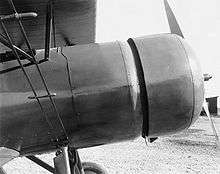NACA cowling


The NACA cowling is a type of aerodynamic fairing used to streamline radial engines for use on airplanes and developed by the National Advisory Committee for Aeronautics in 1927. It was a major advance in drag reduction, and paid for its development and installation costs many times over due to the gains in fuel efficiency that it enabled.[2]
History and design
The NACA cowling enhanced speed through drag reduction while delivering improved engine cooling. The idea that the NACA cowling produced thrust through the Meredith effect[3] is fallacious—although in theory the expansion of the air as it was heated by the engine could create some thrust by exiting at high speed, in practice this required a cowling designed and shaped to achieve the high speed exit of air required (which the NACA cowling was not), and in any case, at 1930s airspeeds, the effect is negligible.[4]
The cowling constitutes a symmetric, circular airfoil, in contrast to the planar airfoil of wings. It directs cool air to flow through the engine where it is routed across the engine's hottest parts, that is, the cylinders and heads. Furthermore, turbulence after the air passes the free-standing cylinders is greatly reduced. The sum of all these effects reduces drag by as much as 60 percent. The test conclusions resulted in almost every radial-engined aircraft being equipped with this cowling, starting in 1932.[5]
The test aircraft, a Curtiss AT-5A Hawk biplane, featuring a Wright Whirlwind J-5 radial engine, reached an airspeed of 137 miles per hour (220 km/h) equipped with the NACA cowling compared to 118 miles per hour (190 km/h) without it.[6]
See also
References
- ↑ White, Graham. Allied Aircraft Piston Engines of World War II. pp. Figures 2.2 & 2.3. ISBN 1-56091-655-9.
- ↑ White, Graham. Allied Aircraft Piston Engines of World War II. pp. 7–8. ISBN 1-56091-655-9.
- ↑ Meredith, F. W: "Cooling of Aircraft Engines. With Special Reference To Ethylene Glycol Radiators Enclosed In Ducts", Aeronautical Research Council R&M 1683, 1936.
- ↑ Becker, J.; The high-speed frontier: Case histories of four NACA programs, 1920- SP-445, NASA (1980), Chapter 5: High-speed Cowlings, Air Inlets and Outlets, and Internal-Flow Systems: The ramjet investigation
- ↑ Full-Scale Testing of N.A.C.A. Cowlings (Theodore Theodorsen, M. J. Brevoort, and George W. Stickle, NACA Report # 592. Langley Memorial Aeronautical Laboratory: 1937)
- ↑ James R. Hansen (1998). "Engineering Science and the Development of the NACA Low-Drag Engine Cowling". History.nasa.gov. Archived from the original on 2004-10-31. Retrieved 2010-07-30.
Other source
- Aeronautic exhibit in Smithsonian Institution, Washington, D.C.
External links
| Wikimedia Commons has media related to NACA cowlings. |